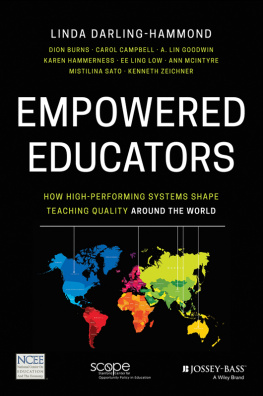
EMPOWERED EDUCATORS IN FINLAND
How High-Performing Systems Shape Teaching Quality
Karen Hammerness
Raisa Ahtiainen
Pasi Sahlberg
Copyright 2017 by The Stanford Center for Opportunity Policy in Education (SCOPE). All rights reserved.
Published by Jossey-Bass
A Wiley Brand
One Montgomery Street, Suite 1000, San Francisco, CA 94104-4594www.josseybass.com
No part of this publication may be reproduced, stored in a retrieval system, or transmitted in any form or by any means, electronic, mechanical, photocopying, recording, scanning, or otherwise, except as permitted under Section 107 or 108 of the 1976 United States Copyright Act, without either the prior written permission of the publisher, or authorization through payment of the appropriate per-copy fee to the Copyright Clearance Center, Inc., 222 Rosewood Drive, Danvers, MA 01923,
978-750-8400, fax 978-646-8600, or on the Web at www.copyright.com. Requests to the publisher for permission should be addressed to the Permissions Department, John Wiley & Sons, Inc., 111 River Street, Hoboken, NJ 07030, 201-748-6011, fax 201-748-6008, or online at www.wiley.com/go/permissions.
Limit of Liability/Disclaimer of Warranty: While the publisher and author have used their best efforts in preparing this book, they make no representations or warranties with respect to the accuracy or completeness of the contents of this book and specifically disclaim any implied warranties of merchantability or fitness for a particular purpose. No warranty may be created or extended by sales representatives or written sales materials. The advice and strategies contained herein may not be suitable for your situation. You should consult with a professional where appropriate. Neither the publisher nor author shall be liable for any loss of profit or any other commercial damages, including but not limited to special, incidental, consequential, or other damages. Readers should be aware that Internet Web sites offered as citations and/or sources for further information may have changed or disappeared between the time this was written and when it is read.
Jossey-Bass books and products are available through most bookstores. To contact Jossey-Bass directly call our Customer Care Department within the U.S. at 800-956-7739, outside the U.S. at 317-572-3986, or fax 317-572-4002.
Wiley publishes in a variety of print and electronic formats and by print-on-demand. Some material included with standard print versions of this book may not be included in e-books or in print-on-demand. If this book refers to media such as a CD or DVD that is not included in the version you purchased, you may download this material at http://booksupport.wiley.com. For more information about Wiley products, visit www.wiley.com.
ISBN: 9781119369714
ISBN: 978111937217
ISBN: 9781119372189
Cover design by Wiley
Cover image: suriya9/Getty Images, Inc.
FOREWORD
FEW WOULD DISAGREE THAT, among all the factors that affect how much students learn, the quality of their teachers ranks very high. But what, exactly, do policy makers, universities, and school leaders need to do to make sure that the vast majority of teachers in their jurisdiction are literally world class?
Perhaps the best way to answer that question is to look carefully and in great detail at what the countries whose students are performing at the worlds top levels are doing to attract the highest quality high school students to teaching careers, prepare them well for that career, organize schools so teachers can do the best work of which they are capable, and provide incentives for them to get better at the work before they finally retire.
It was not hard for us to find the right person to lead a study that would do just that. Stanford professor Linda Darling-Hammond is one of the worlds most admired researchers. Teachers and teaching have been lifelong professional preoccupations for her. And, not least, Professor Darling-Hammond is no stranger to international comparative studies. Fortunately for us and for you, she agreed to lead an international comparative study of teacher quality in a selection of top-performing countries. The study, Empowered Educators: How High-Performing Systems Shape Teaching Quality Around the World, took two years to complete and is unprecedented in scope and scale.
The volume you are reading is one of six books, including case studies conducted in Australia, Canada, China, Finland, and Singapore. In addition to the case studies and the cross-study analysis, the researchers have collected a range of videos and artifacts (http://ncee.org/empowered-educators)ranging from a detailed look at how the daily schedules of teachers in Singapore ensure ample time for collaboration and planning to a description of the way Shanghai teachers publish their classroom research in refereed journalsthat we hope will be of great value to policy makers and educators interested in using and adapting the tools that the top-performing jurisdictions use to get the highest levels of teacher quality in the world.
Studies of this sort are often done by leading scholars who assemble hordes of graduate students to do the actual work, producing reams of reports framed by the research plan, which are then analyzed by the principal investigator. That is not what happened in this case. For this report, Professor Darling-Hammond recruited two lead researcher-writers for each case study, both senior, one from the country being studied and one from another country, including top-level designers and implementers of the systems being studied and leading researchers. This combination of insiders and external observers, scholars and practitioner-policy makers, gives this study a depth, range, and authenticity that is highly unusual.
But this was not just an effort to produce first-class case studies. The aim was to understand what the leaders were doing to restructure the profession of teaching for top performance. The idea was to cast light on that by examining what was the same and what was different from country to country to see if there were common threads that could explain uncommon results. As the data-gathering proceeded, Professor Darling-Hammond brought her team together to exchange data, compare insights, and argue about what the data meant. Those conversations, taking place among a remarkable group of senior policy actors, practitioners, and university-based researchers from all over the world, give this work a richness rarely achieved in this sort of study.
The researchers examined all sorts of existing research literature on the systems they were studying, interviewed dozens of people at every level of the target systems, looked at everything from policy at the national level to practice in individual schools, and investigated not only the specific policies and practices directly related to teacher quality, but the larger economic, political, institutional, and cultural contexts in which policies on teacher quality are shaped.
Through it all, what emerges is a picture of a sea change taking place in the paradigm of mass education in the advanced industrial nations. When university graduates of any kind were scarce and most people had jobs requiring only modest academic skills, countries needed teachers who knew little more than the average high school graduate, perhaps less than that at the primary school level. It was not too hard to find capable people, typically women, to do that work, because the job opportunities for women with that level of education were limited.
Next page












